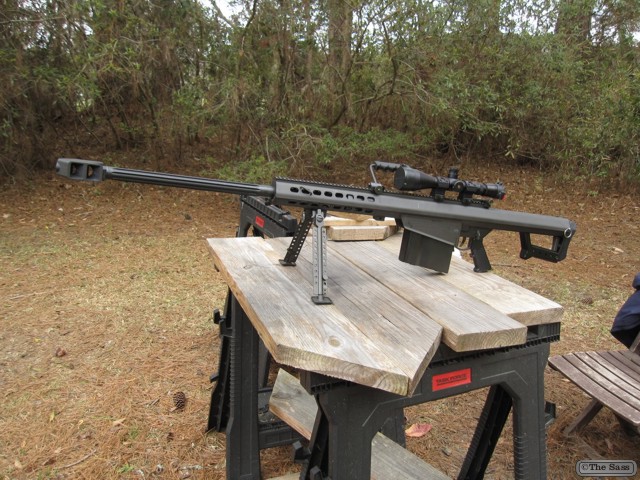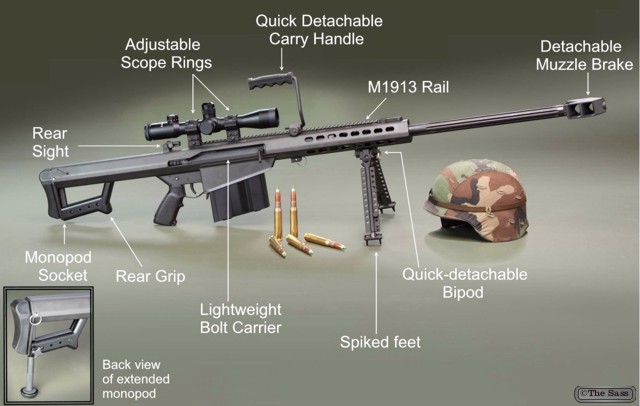The M82, standardized by the US Military as the M107, is a recoil-operated, semi-automatic anti-materiel rifle developed by the American Barrett Firearms Manufacturing company. It is used by many units and armies around the world. Despite its designation as an anti-materiel rifle, it is used by some armed forces as an anti-personnel sniper rifle. It is also called the Light Fifty for its .50 BMG (12.7×99mm NATO) chambering. The weapon is found in two variants, the original M82A1 (and A3) and the bullpup M82A2. The M82A2 is no longer manufactured, though the XM500 can be seen as its successor.
Overview
Barrett Firearms Manufacturing was founded by Ronnie Barrett for the sole purpose of building semi-automatic rifles chambered for the powerful 12.7×99mm NATO (.50 BMG) ammunition, originally developed for and used in M2 Browning machine guns. Barrett began his work in the early 1980s and the first working rifles were available in 1982, hence the designation M82. Barrett designed every single part of the weapon personally and then went on to market the weapon and mass-produce it out of his own pocket. He continued to develop his rifle through the 1980s, and developed the improved M82A1 rifle by 1986.
The first conventional military success was the sale of about 100 M82A1 rifles to the Swedish Army in 1989. Major success followed in 1990, when the United States armed forces purchased significant numbers of the M82A1 during operations Desert Shield and Desert Storm in Kuwait and Iraq. About 125 rifles were initially bought by the United States Marine Corps, and orders from the Army and Air Force soon followed. The M82A1 is known by the US military as the SASR – “Special Applications Scoped Rifle”, and it was and still is used as an anti-materiel rifle and explosive ordnance disposal (EOD) tool. The long effective range, over 1,800 metres (5,900 ft) (1.1 miles), along with high energy and availability of highly effective ammunition such as API and Raufoss Mk 211, allows for effective operations against targets like radar cabins, trucks, parked aircraft and the like. The M82 can also be used to defeat human targets from standoff range or against targets behind cover. However, anti-personnel use is not a major application for the M82. There is a widespread misconception that a number of treaties have banned use of the .50 BMG against human targets.
Technical Description
The M82 is a short recoil semi-automatic firearm. When the gun is fired, the barrel initially recoils for a short distance (about 1 in or 25 mm), while being securely locked by the rotating bolt. After the short travel, a post on the bolt engaged in the curved cam track in the receiver turns the bolt to unlock it from the barrel. As soon as the bolt unlocks, the accelerator arm strikes it back, transferring part of the recoil energy of the barrel to the bolt to achieve reliable cycling. Then the barrel is stopped and the bolt continues back, to extract and eject a spent case. On its return stroke, the bolt strips the fresh cartridge from the box magazine and feeds it into the chamber and finally locks itself to the barrel. The striker is also cocked on the return stroke of the bolt. The gun is fed from a large detachable box magazine holding up to 10 rounds, although a rare 12-round magazine was developed for use during Operation Desert Storm in 1991.
The receiver is made from two parts (upper and lower), stamped from sheet steel and connected by cross-pins. The heavy barrel is fluted to improve heat dissipation and save weight, and fitted with a large and effective reactive muzzle brake. On the earlier models the muzzle brakes had a round cross-section; later M82 rifles are equipped with two-chamber brakes of rectangular cross-section.
M82A1 rifles are fitted with scope mount and folding backup iron sights, should the glass scope break. The U.S. military M82 rifles are often equipped with Leupold Mark 4 telescopic sights. The M82A1M (USMC M82A3) rifles have long Picatinny accessory rails mounted and US Optics telescopic sights. Every M82 rifle is equipped with a folding carrying handle and a folding bipod (both are detachable on the M82A3). The M82A3 is also fitted with a detachable rear monopod under the butt. The buttpad is fitted with a soft recoil pad to further decrease the felt recoil. M82A1 and M82A3 rifles could be mounted on the M3 or M122 infantry tripods (originally intended for machine guns) or on vehicles using the special Barrett soft-mount. The M82A1 can be fitted with a carry sling but according to those who carried it in the field, the M82 is too uncomfortable to be carried on a sling due to its excessive length and weight. It is usually carried in a special carry soft or hard case.
The M82A2 differed from M82A1 mostly in its configuration – the pistol grip along with trigger was placed ahead of the magazine, and the buttpad placed below the receiver, just after the magazine. An additional forward grip was added below the receiver, and the scope mount moved forward.
The maximum effective range of the M107 is 1,830 metres (2,000 yd). The maximum range of this weapon (specifically the M107 variant) is 4,000 metres (4,400 yd), as quoted in the owner’s manual. Fifty caliber (and larger) rounds have the potential to travel great distances if fired in an artillery-like fashion, necessitating the observance of large safety margins when firing on a range.
The Sass



Leave a Reply